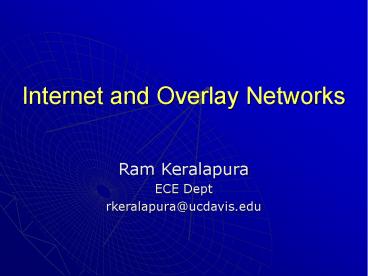Internet and Overlay Networks - PowerPoint PPT Presentation
Title:
Internet and Overlay Networks
Description:
Internet and Overlay Networks Ram Keralapura ECE Dept rkeralapura_at_ucdavis.edu – PowerPoint PPT presentation
Number of Views:196
Avg rating:3.0/5.0
Title: Internet and Overlay Networks
1
Internet and Overlay Networks
- Ram Keralapura
- ECE Dept
- rkeralapura_at_ucdavis.edu
2
Layered Architecture
- Five main layers
- Application layer
- Transport layer
- Network (IP) layer
- Link layer
- Physical/Optical layer
Applications/Computers Application layer links
Routers Virtual IP links
Optical switches Optical fibers
3
Introduction
- Internet Routing Infrastructure
- Intra-domain routing (IGP)
- RIP, OSFP, ISIS, etc.
- Inter-domain routing
- BGP
Internet
Domain or Autonomous System
4
Intra-domain Routing
- Links are assigned link costs/weights
- Path between two nodes inside a domain follows
shortest path (least cost path)
5
Network Properties
- Important properties of networks that service
providers look for - Connectivity
- Performance
- Resiliency
- Robustness in functionality
- Service availability delivering a given packet
from source to destination
6
Characterizing Networks
- Main causes for concern resiliency and
robustness - How does the IGP protocol behave during network
component failures? - How does the behavior impact the data that the
network carries?
7
Characterizing Networks (contd)
- We have developed a model that captures the
dynamic behavior of the network protocols during
link failures Keralapura et al, 2004 - Protocol convergence depends on
- Topology nodes and connectivity
- Protocol timer settings
- Number of entries to update in the forwarding
tables
8
Characterizing Networks (contd)
- Metrics for service availability
- Service disruption time
- Traffic disruption
- Based on the above metrics we define goodness
factor for the network
9
Results (contd)
Ingress Node Goodness
Static properties (like node out-degree) do not
capture operational conditions and network
dynamics
Out Degree
Ingress Node Goodness
Out Degree
10
Network Goodness
Network Diameter
Similar results were also found in the paper
Layered Complex Networks by Kurant and Thiran
11
Internet Architecture
- Tiered hierarchy in domains
Peering relationship
Tier-1 B
Tier-1 A
Tier-2 C
Tier-2 D
Tier-2 F
Tier-2 E
Customer-Provider relationship
12
Inter-domain routing
- Policy-based routing
- Ad-hoc and can change with agreements with other
domains - Can we capture these policies?
- Domains do not disclose their connectivity
- Policies can obstruct views and hinder
domain-level topology discovery - Need multiple vantage points for more accurate
topology information
13
Application Layer Networks
- Email Networks
- World Wide Web (WWW)
- Peer-to-Peer (p2p) Networks
- Several Content Delivery Networks (CDN)
Overlay networks
14
Background Overlay Networks
B
D
Domain-2
A
B
Y
X
D
C
A
Domain-4
Domain-1
Domain-3
C
15
Interaction between networks
- Overlay networks compete with IP networks to
provide routing service - IP and overlay networks are unaware of key things
happening at the other layer - Multiple overlay networks co-exist and make
independent decisions - How does all this affect IP and overlay networks?
16
Interactions between Networks
- Identified some potential interactions
Keralapura et al, 2005 - Traffic engineering in IP networks
- Load balancing issues
- IP layer traffic matrix estimation
- Coupling of multiple domains
- Defeats the objective of BGP
- Multiple co-existing overlay networks
- Traffic oscillations
- Cascading reactions
17
Load Balancing and TM Estimation
F
5
5
G
H
5
5
5
8
N
M
5
A
E
20
5
8
5
5
B
D
5
5
C
18
Coupling Multiple AS Domains
F
B
X
G
C
E
A
H
D
Domain-2
Domain-1
Defeats one of the objectives of BGP to decouple
different domains
19
Traffic Oscillations
Traffic Oscillations
Failure of link 10-12
Failure of link 2-5
20
Open questions
- Interactions need to be understood better and we
need to model them - How to go about characterizing the robustness of
a network after we model such interactions? - Are there interactions between networks at other
layers? - If yes, then how to we qualify, quantify, and
model them?































